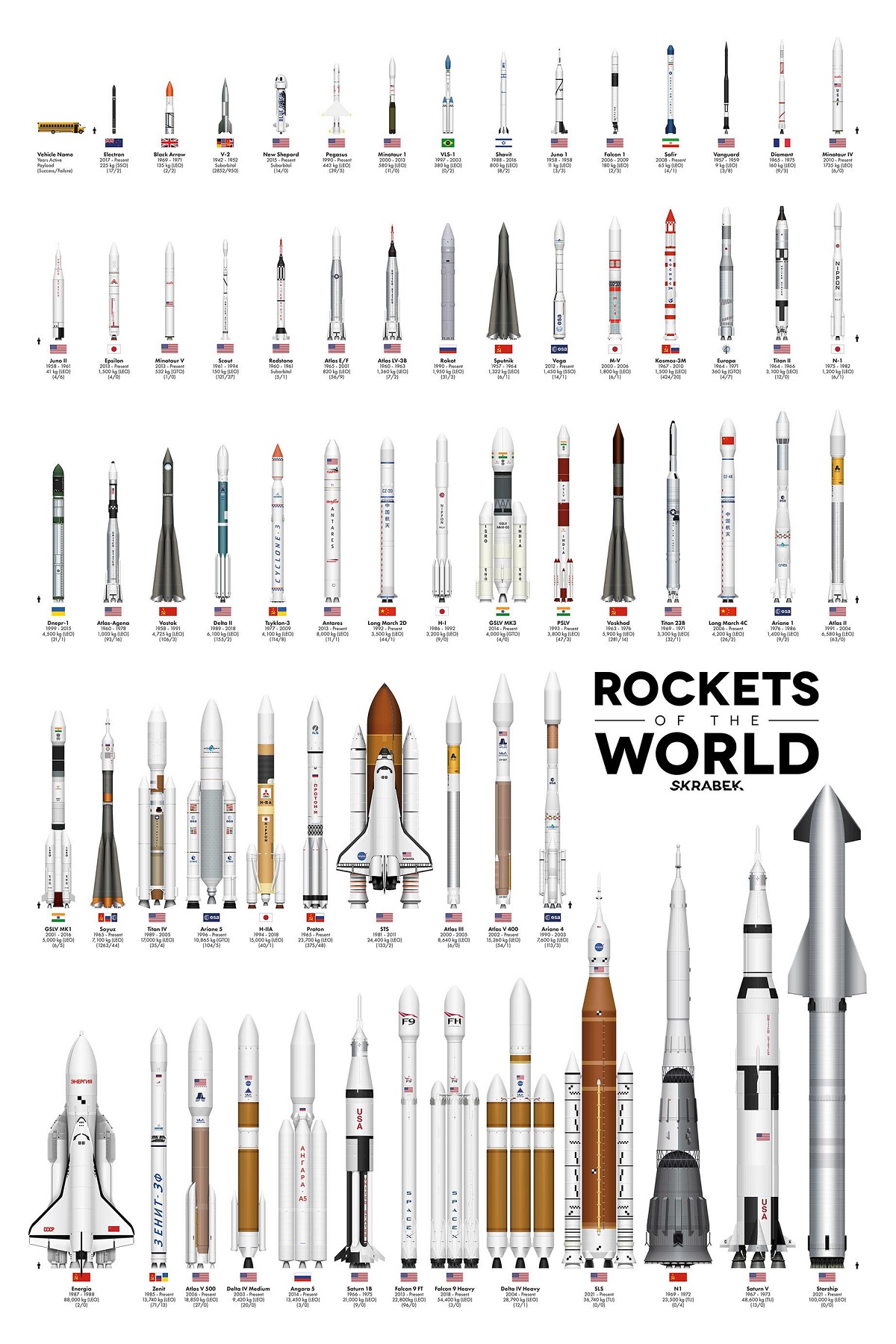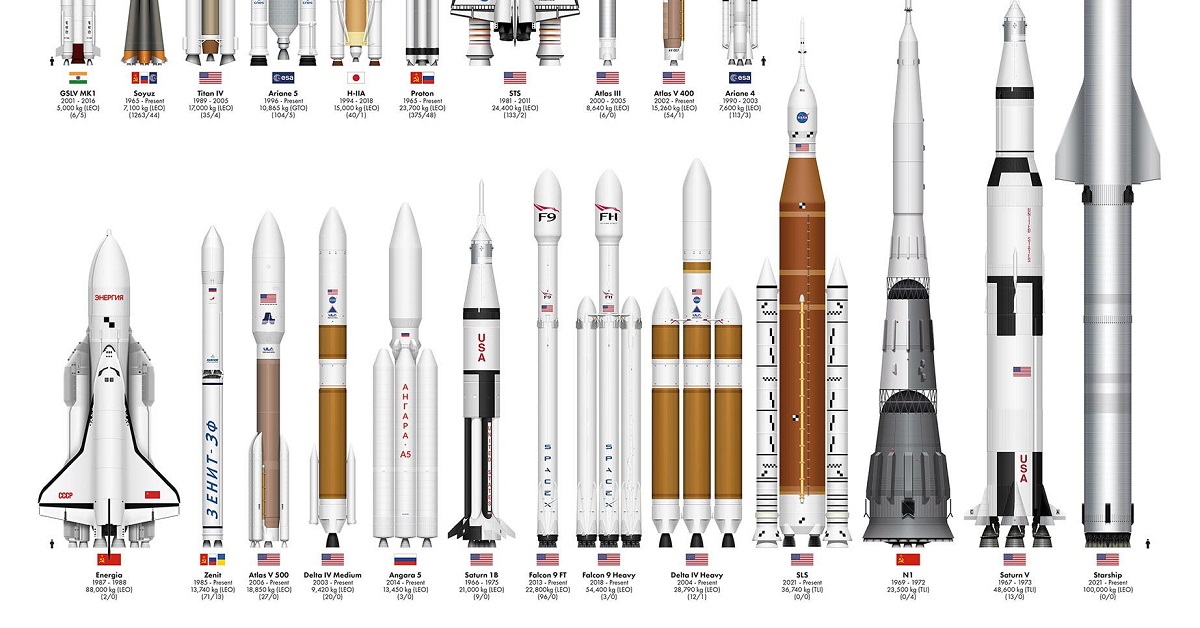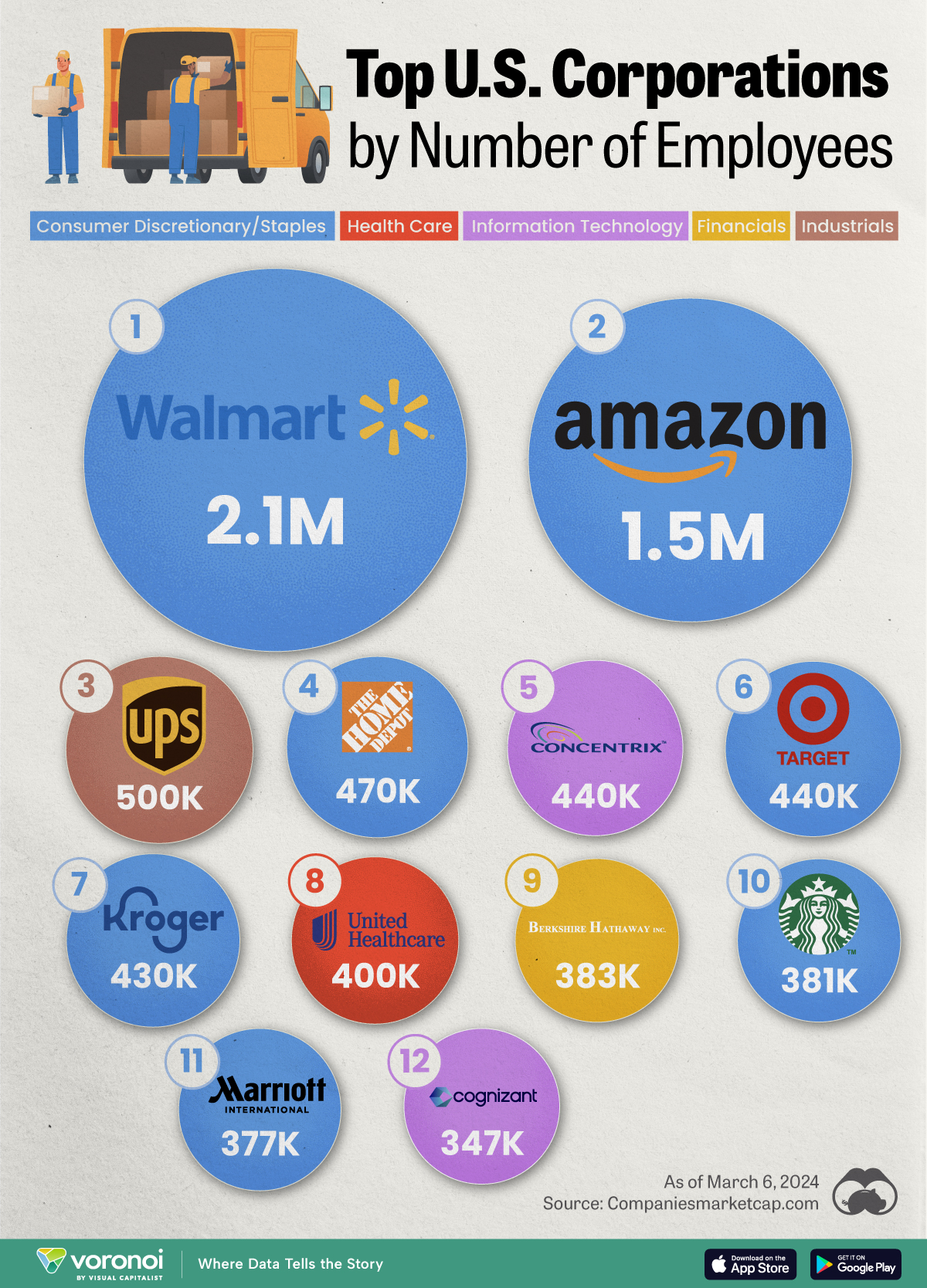United States
Comparing the Size of The World’s Rockets, Past and Present
View the full-size version of this infographic

The Size of The World’s Rockets, Past and Present
The SpaceX Starship might be the next rocket to take humans to the moon, but it won’t be the first, and likely not the last.
Starting in the mid-20th century, humanity has explored space faster than ever before. We’ve launched satellites, telescopes, space stations, and spacecrafts, all strapped to rocket-propelled launch vehicles that helped them breach our atmosphere.
This infographic from designer Tyler Skarbek stacks up the many different rockets of the world side-by-side, showing which country designed them, what years they were used, and what they (could) accomplish.
How Do The World’s Rockets Stack Up?
Before they were used for space travel, rockets were produced and developed to be used as ballistic missiles.
The first rocket to officially reach space—defined by the Fédération Aéronautique Internationale as crossing the Kármán line at 100 kilometers (62 miles) above Earth’s mean sea level—was the German-produced V-2 rocket in 1944.
But after World War II, V-2 production fell into the hands of the U.S., the Soviet Union (USSR), and the UK.
Over the next few decades and the unfolding of the Cold War, what started as a nuclear arms race of superior ballistic missiles turned into the Space Race. Both the U.S. and the USSR tried to be the first to achieve and master spaceflight, driving production of many new and different rockets.
| Origin Country | Rocket | Years Active | Payload (Range) | Success/Failure |
|---|---|---|---|---|
| Germany | V-2 | 1942–1952 | (Suborbital) | 2852/950 |
| U.S. | Vanguard | 1957–1959 | 9 kg (LEO) | 3/8 |
| USSR | Sputnik | 1957–1964 | 1,322 kg (LEO) | 6/1 |
| U.S. | Juno 1 | 1958–1958 | 11 kg (LEO) | 3/3 |
| U.S. | Juno II | 1958–1961 | 41 kg (LEO) | 4/6 |
| USSR | Vostok | 1958–1991 | 4,725 kg (LEO) | 106/3 |
| U.S. | Redstone | 1960–1961 | 1,800 kg (Suborbital) | 5/1 |
| U.S. | Atlas LV-3B | 1960–1963 | 1,360 kg (LEO) | 7/2 |
| U.S. | Atlas-Agena | 1960–1978 | 1,000 kg (LEO) | 93/16 |
| U.S. | Scout | 1961–1994 | 150 kg (LEO) | 121/27 |
| USSR | Voskhod | 1963–1976 | 5,900 kg (LEO) | 281/14 |
| U.S. | Titan II | 1964–1966 | 3,100 kg (LEO) | 12/0 |
| Europe (ELDO) | Europa | 1964–1971 | 360 kg (GTO) | 4/7 |
| France | Diamant | 1965–1975 | 160 kg (LEO) | 9/3 |
| U.S. | Atlas E/F | 1965–2001 | 820 kg (LEO) | 56/9 |
| USSR | Soyuz | 1965–Present | 7,100 kg (LEO) | 1263/44 |
| USSR | Proton | 1965–Present | 23,700 kg (LEO) | 375/48 |
| U.S. | Saturn 1B | 1966–1975 | 21,000 kg (LEO) | 9/0 |
| U.S. | Saturn V | 1967–1973 | 48,600 kg (TLI) | 13/0 |
| USSR | Kosmos-3M | 1967–2010 | 1,500 kg (LEO) | 424/20 |
| UK | Black Arrow | 1969–1971 | 135 kg (LEO) | 2/2 |
| U.S. | Titan 23B | 1969–1971 | 3,300 kg (LEO) | 32/1 |
| USSR | N1 | 1969–1972 | 23,500 kg (TLI) | 0/4 |
| Japan | N-1 | 1975–1982 | 1,200 kg (LEO) | 6/1 |
| Europe (ESA) | Ariane 1 | 1976–1986 | 1,400 kg (LEO) | 9/2 |
| USSR | Tsyklon-3 | 1977–2009 | 4,100 kg (LEO) | 114/8 |
| U.S. | STS | 1981–2011 | 24,400 kg (LEO) | 133/2 |
| USSR | Zenit | 1985–Present | 13,740 kg (LEO) | 71/13 |
| Japan | H-I | 1986–1992 | 3,200 kg (LEO) | 9/0 |
| USSR | Energia | 1987–1988 | 88,000 kg (LEO) | 2/0 |
| Israel | Shavit | 1988–2016 | 800 kg (LEO) | 8/2 |
| U.S. | Titan IV | 1989–2005 | 17,000 kg (LEO) | 35/4 |
| U.S. | Delta II | 1989–2018 | 6,100 kg (LEO) | 155/2 |
| Europe (ESA) | Ariane 4 | 1990–2003 | 7,600 kg (LEO) | 113/3 |
| U.S. | Pegasus | 1990–Present | 443 kg (LEO) | 39/5 |
| Russia | Rokot | 1990–Present | 1,950 kg (LEO) | 31/3 |
| U.S. | Atlas II | 1991–2004 | 6,580 kg (LEO) | 63/0 |
| China | Long March 2D | 1992–Present | 3,500 kg (LEO) | 44/1 |
| India | PSLV | 1993–Present | 3,800 kg (LEO) | 47/3 |
| Japan | H-IIA | 1994–2018 | 15,000 kg (LEO) | 40/1 |
| Europe (ESA) | Ariane 5 | 1996–Present | 10,865 kg (GTO) | 104/5 |
| Brazil | VLS-1 | 1997–2003 | 380 kg (LEO) | 0/2 |
| USSR | Dnepr-1 | 1999–2015 | 4,500 kg (LEO) | 21/1 |
| U.S. | Atlas III | 2000–2005 | 8,640 kg (LEO) | 6/0 |
| Japan | M-V | 2000–2006 | 1,800 kg (LEO) | 6/1 |
| U.S. | Minotaur 1 | 2000–2013 | 580 kg (LEO) | 11/0 |
| India | GSLV MK1 | 2001–2016 | 5,000 kg (LEO) | 6/5 |
| U.S. | Atlas V 400 | 2002–Present | 15,260 kg (LEO) | 54/1 |
| U.S. | Delta IV Medium | 2003–Present | 9,420 kg (LEO) | 20/0 |
| U.S. | Delta IV Heavy | 2004–Present | 28,790 kg (LEO) | 12/1 |
| U.S. | Falcon 1 | 2006–2009 | 180 kg (LEO) | 2/3 |
| China | Long March 4C | 2006–Present | 4,200 kg (LEO) | 26/2 |
| U.S. | Atlas V 500 | 2006–Present | 18,850 kg (LEO) | 27/0 |
| Iran | Safir | 2008–Present | 65 kg (LEO) | 4/1 |
| U.S. | Minotaur IV | 2010–Present | 1,735 kg (LEO) | 6/0 |
| Europe (ESA) | Vega | 2012–Present | 1,450 kg (SSO) | 14/1 |
| U.S. | Minotaur V | 2013–Present | 532 kg (GTO) | 1/0 |
| Japan | Epsilon | 2013–Present | 1,500 kg (LEO) | 4/0 |
| U.S. | Antares | 2013–Present | 8,000 kg (LEO) | 11/1 |
| U.S. | Falcon 9 FT | 2013–Present | 22,800 kg (LEO) | 96/0 |
| India | GSLV MK3 | 2014–Present | 4,000 kg (GTO) | 4/0 |
| Russia | Angara 5 | 2014–Present | 13,450 kg (LEO) | 3/0 |
| U.S. | New Shepard | 2015–Present | (Suborbital) | 14/0 |
| New Zealand | Electron | 2017–Present | 225 kg (SSO) | 17/2 |
| U.S. | Falcon 9 Heavy | 2018–Present | 54,400 kg (LEO) | 3/0 |
| U.S. | Starship | 2021–Present | 100,000 kg (LEO) | 0/0 |
| U.S. | SLS | 2021–Present | 36,740 kg (TLI) | 0/0 |
As the Space Race wound down, the U.S. proved to be the biggest producer of different rockets. The eventual dissolution of the USSR in 1991 transferred production of Soviet rockets to Russia or Ukraine. Then later, both Europe (through the European Space Agency) and Japan ramped up rocket production as well.
More recently, new countries have since joined the race, including China, Iran, and India. Though the above infographic shows many different families of rockets, it doesn’t include all, including China’s Kuaizhou rocket and Iran’s Zuljanah and Qased rockets.
Rocket Range Explained and Continued Space Aspirations
Designing a rocket that can reach far into space while carrying a heavy payload—the objects or entities being carried by a vehicle—is extremely difficult and precise. It’s not called rocket science for nothing.
When rockets are designed, they are are created with one specific range in mind that takes into account the fuel needed to travel and velocity achievable. Alternatively, they have different payload ratings depending on what’s achievable and reliable based on the target range.
- Suborbital: Reaches outer space, but its trajectory intersects the atmosphere and comes back down. It won’t be able to complete an orbital revolution or reach escape velocity.
- LEO (Low Earth orbit): Reaches altitude of up to ~2,000 km (1242.74 miles) and orbits the Earth at an orbital period of 128 minutes or less (or 11.25 orbits per day).
- SSO (Sun-synchronous orbit): Reaches around 600–800 km above Earth in altitude but orbits at an inclination of ~98°, or nearly from pole to pole, in order to keep consistent solar time.
- GTO (Geosynchronous transfer orbit): Launches into a highly elliptical orbit which gets as close in altitude as LEO and as far away as 35,786 km (22,236 miles) above sea level.
- TLI (Trans-lunar injection): Launches on a trajectory (or accelerates from Earth orbit) to reach the Moon, an average distance of 384,400 km (238,900 miles) from Earth.
But there are other ranges and orbits in the eyes of potential spacefarers. Mars for example, a lofty target in the eyes of SpaceX and billionaire founder Elon Musk, is between about 54 and 103 million km (34 and 64 million miles) from Earth at its closest approach.
With space exploration becoming more common, and lucrative enough to warrant billion-dollar lawsuits over contract awards, how far will future rockets go?
United States
Ranked: The Largest U.S. Corporations by Number of Employees
We visualized the top U.S. companies by employees, revealing the massive scale of retailers like Walmart, Target, and Home Depot.

The Largest U.S. Corporations by Number of Employees
This was originally posted on our Voronoi app. Download the app for free on Apple or Android and discover incredible data-driven charts from a variety of trusted sources.
Revenue and profit are common measures for measuring the size of a business, but what about employee headcount?
To see how big companies have become from a human perspective, we’ve visualized the top U.S. companies by employees. These figures come from companiesmarketcap.com, and were accessed in March 2024. Note that this ranking includes publicly-traded companies only.
Data and Highlights
The data we used to create this list of largest U.S. corporations by number of employees can be found in the table below.
| Company | Sector | Number of Employees |
|---|---|---|
| Walmart | Consumer Staples | 2,100,000 |
| Amazon | Consumer Discretionary | 1,500,000 |
| UPS | Industrials | 500,000 |
| Home Depot | Consumer Discretionary | 470,000 |
| Concentrix | Information Technology | 440,000 |
| Target | Consumer Staples | 440,000 |
| Kroger | Consumer Staples | 430,000 |
| UnitedHealth | Health Care | 400,000 |
| Berkshire Hathaway | Financials | 383,000 |
| Starbucks | Consumer Discretionary | 381,000 |
| Marriott International | Consumer Discretionary | 377,000 |
| Cognizant | Information Technology | 346,600 |
Retail and Logistics Top the List
Companies like Walmart, Target, and Kroger have a massive headcount due to having many locations spread across the country, which require everything from cashiers to IT professionals.
Moving goods around the world is also highly labor intensive, explaining why UPS has half a million employees globally.
Below the Radar?
Two companies that rank among the largest U.S. corporations by employees which may be less familiar to the public include Concentrix and Cognizant. Both of these companies are B2B brands, meaning they primarily work with other companies rather than consumers. This contrasts with brands like Amazon or Home Depot, which are much more visible among average consumers.
A Note on Berkshire Hathaway
Warren Buffett’s company doesn’t directly employ 383,000 people. This headcount actually includes the employees of the firm’s many subsidiaries, such as GEICO (insurance), Dairy Queen (retail), and Duracell (batteries).
If you’re curious to see how Buffett’s empire has grown over the years, check out this animated graphic that visualizes the growth of Berkshire Hathaway’s portfolio from 1994 to 2022.
-

 Mining1 week ago
Mining1 week agoGold vs. S&P 500: Which Has Grown More Over Five Years?
-

 Markets2 weeks ago
Markets2 weeks agoRanked: The Most Valuable Housing Markets in America
-

 Money2 weeks ago
Money2 weeks agoWhich States Have the Highest Minimum Wage in America?
-

 AI2 weeks ago
AI2 weeks agoRanked: Semiconductor Companies by Industry Revenue Share
-

 Markets2 weeks ago
Markets2 weeks agoRanked: The World’s Top Flight Routes, by Revenue
-

 Countries2 weeks ago
Countries2 weeks agoPopulation Projections: The World’s 6 Largest Countries in 2075
-

 Markets2 weeks ago
Markets2 weeks agoThe Top 10 States by Real GDP Growth in 2023
-

 Demographics2 weeks ago
Demographics2 weeks agoThe Smallest Gender Wage Gaps in OECD Countries












